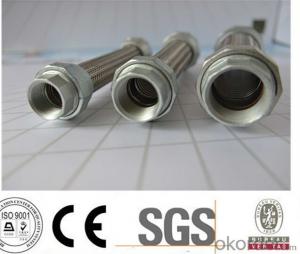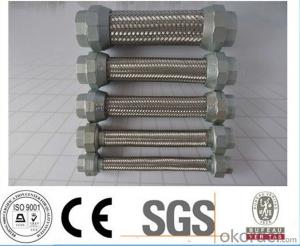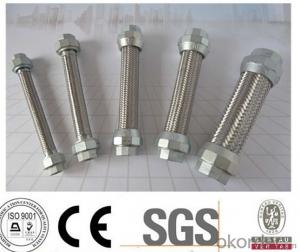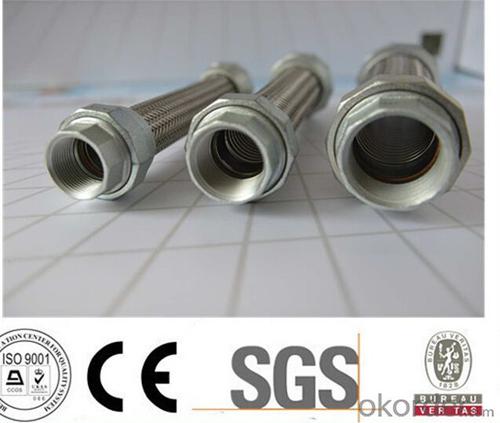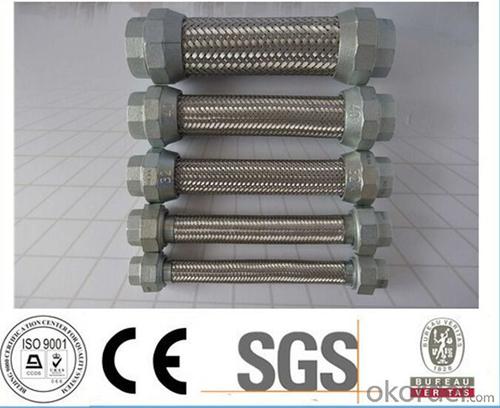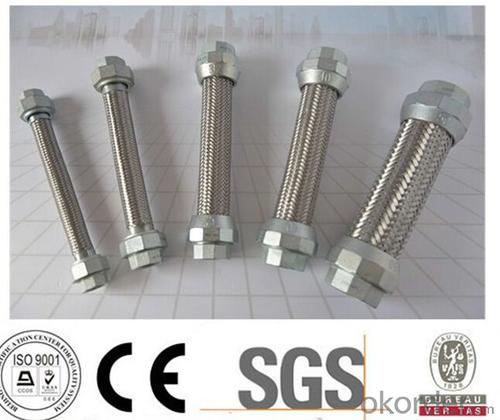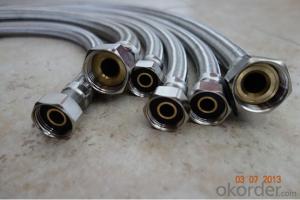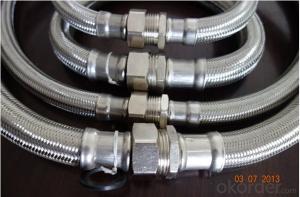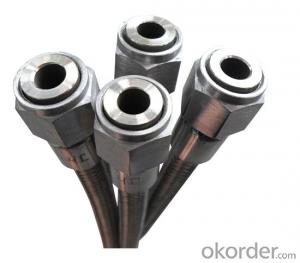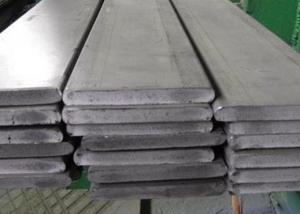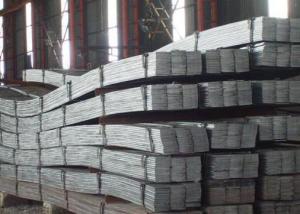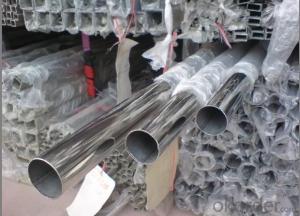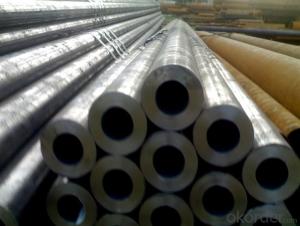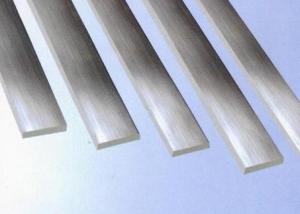Stainless Steel Braid Hose with 1/2'' Fittings
- Loading Port:
- Tianjin
- Payment Terms:
- TT OR LC
- Min Order Qty:
- 1000 pc
- Supply Capability:
- 100000 pc/month
OKorder Service Pledge
OKorder Financial Service
You Might Also Like
Specification
Stainless Steel Braid Hose with 1/2'' Fittings
Applications of Stainless Steel Braid Hose with 1/2'' Fittings:
--Refueling system
--Chemical and pharmaceutical industry
--Industrial hydraulic systems
--Air conditioners in industrial and construction –site vehicles
--Food and beverage industry
--Special and standard industrial applications
--Water and cleaning management
Features of Stainless Steel Braid Hose with 1/2'' Fittings:
1. )O. D.: 13-18MM 0.2-3M long
2. )Nut.: Nickel/Chrome Plated Brass (Zinc / Iron / Aluminum is available)
3. )Size Of Nut.: Female&Male 1/2''; 3/4''; 3/8''; 7/8''; 5/16'', and M10...
4. )Insert.: Brass (Zinc / Aluminum / Plastic is available)
5. )Inner tube.: Rubber/ EPDM/PVC
6. )Covered Material: Stainless Steel 201, 301, 304 /Aluminium Wire
7. )Working Pressure: 5Kg-15Kg
8. )Temperature: 0-92° C
9. )Quality Assurance: 3 years
RemarkAPPLICATION: HOUSEEHOLD WARE, BATHROOM WARE, SHOWER HOSE
PAYMENT: T/T, L/C
DELIVERY TIME: 20DAYS OR 30DAYS AFTER RECEIVED 30% DEPOSITS
MOQ: 5000PCS
ODM&OEM IS ACCEPTABLE
PackageInner: PP bag /Blister packing Outer: Carton box
Specifications of Stainless Steel Braid Hose with 1/2'' Fittings:
NO | I.D | Refer to O.D | Working pressure | Burst pressure | approximate Weight | |||||
(inch) | (mm) | (inch) | (mm) | MPa | Psi | MPa | Psi | kg/m | lbs/ft | |
1 | 1/8 | 3.2±0.2 | 0.35 | 9±0.3 | 2.06 | 300 | 8.27 | 1200 | 0.078 | 0.12 |
2 | 5/32 | 4±0.2 | 0.4 | 10±0.3 | 2.06 | 300 | 8.27 | 1200 | 0.092 | 0.14 |
3 | 3/16 | 4.8±0.2 | 0.43 | 11±0.3 | 2.06 | 300 | 8.27 | 1200 | 0.108 | 0.16 |
4 | 1/4 | 6.3±0.3 | 0.5 | 12.7±0.3 | 2.06 | 300 | 8.27 | 1200 | 0.134 | 0.2 |
5 | 5/16 | 8.0±0.3 | 0.56 | 14±0.3 | 2.06 | 300 | 8.27 | 1200 | 0.147 | 0.22 |
6 | 3/8 | 9.5±0.3 | 0.63 | 16±0.4 | 2.06 | 300 | 8.27 | 1200 | 0.182 | 0.27 |
7 | 15/32 | 12±0.3 | 0.75 | 19±0.5 | 2.06 | 300 | 8.27 | 1200 | 0.238 | 0.35 |
8 | 1/2 | 12.7±0.4 | 0.78 | 20±0.5 | 2.06 | 300 | 8.27 | 1200 | 0.262 | 0.39 |
9 | 5/8 | 16±0.4 | 0.94 | 24±0.5 | 1.03 | 150 | 4.12 | 600 | 0.351 | 0.52 |
10 | 3/4 | 19±0.4 | 1.13 | 28.8±0.5 | 1.03 | 150 | 4.12 | 600 | 0.515 | 0.77 |
11 | 1 | 25.4±0.5 | 1.38 | 35±0.6 | 1.03 | 150 | 4.12 | 600 | 0.637 | 0.95 |
Images of Stainless Steel Braid Hose with 1/2'' Fittings:
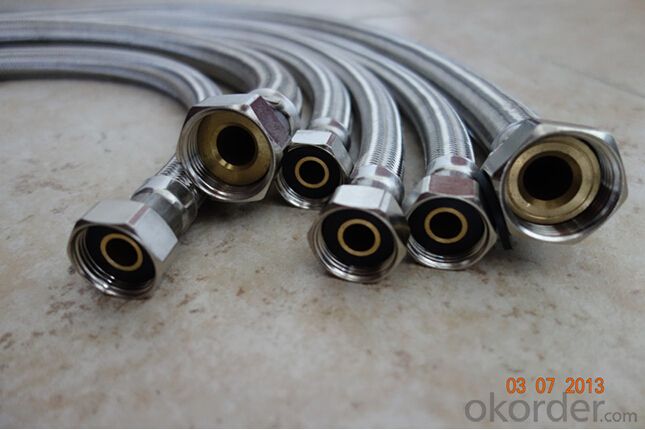
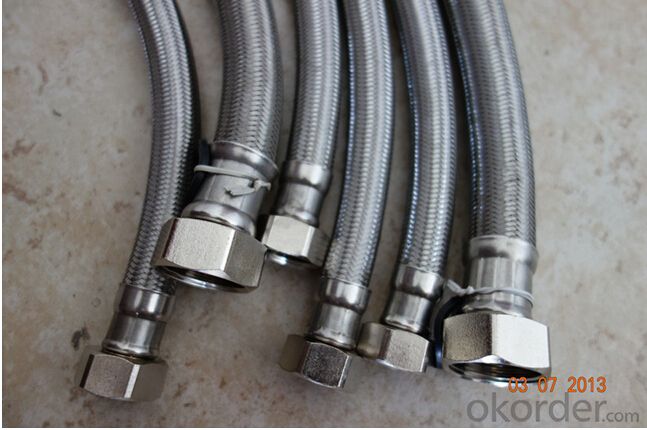
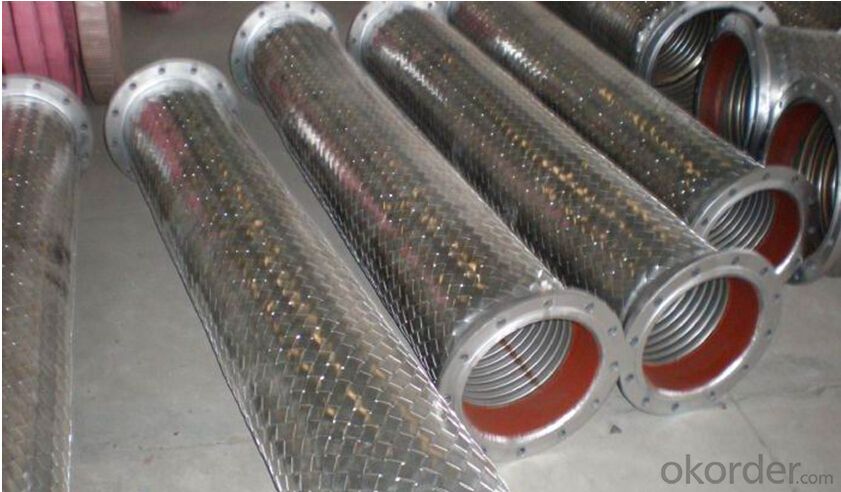

Package of Stainless Steel Braid Hose with 1/2'' Fittings:
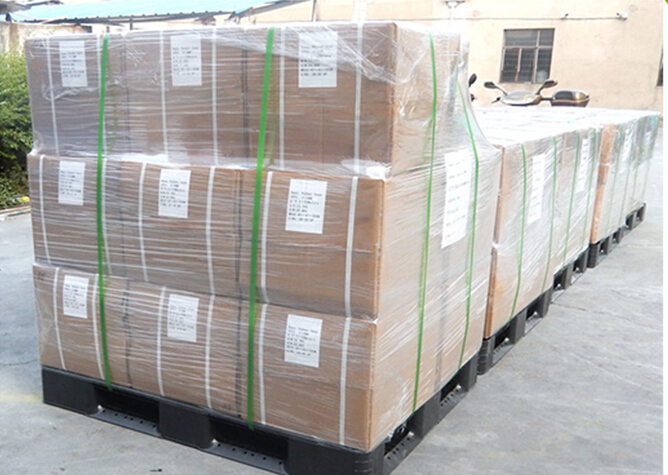
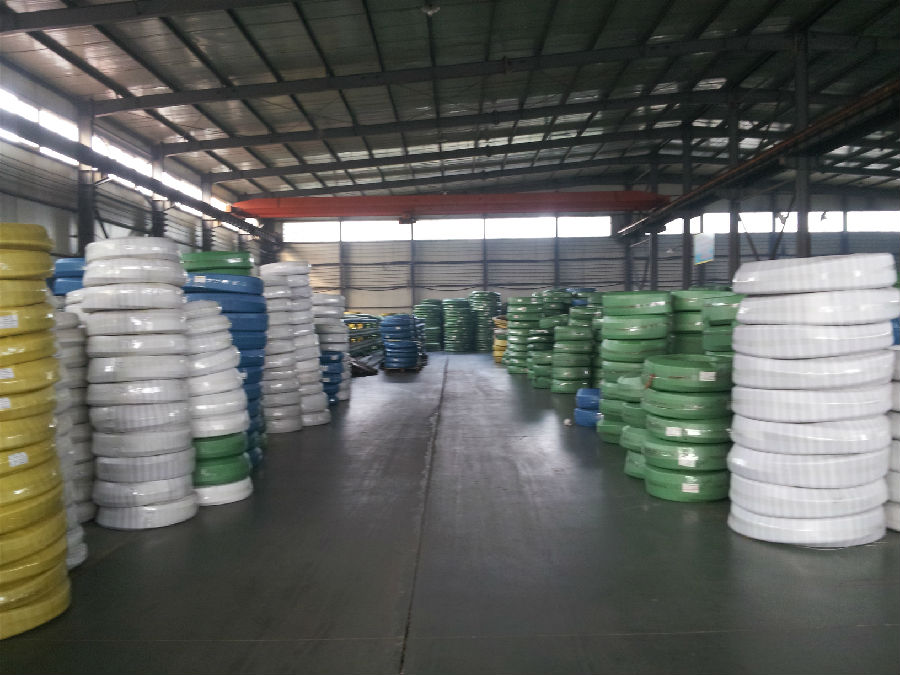
FAQ of Stainless Steel Braid Hose with 1/2'' Fittings:
Who we are:
Answer: We CNBM is a Chinese state-owned enterprise ranked 267th among the Global Fortune 500, as the largest building materials company,we have over 300 affiliated companies,and so many production lines and branch office distribute in China.
2. About our quality:
Answer: Every product needs to be quality proved before shipping.
3. About our service:
Answer: We could gurantte that we can reply you in 2 working hours.
- Q: What are the factors to consider when selecting a stainless steel pipe for a specific application?
- When selecting a stainless steel pipe for a specific application, there are several factors to consider. These factors include the required corrosion resistance, temperature and pressure requirements, the type of fluid or gas being transported, the pipe size and thickness, the desired strength and durability, and any specific industry standards or regulations that need to be followed. Additionally, the cost, availability, and ease of installation should also be taken into account. Overall, it is important to carefully evaluate these factors to ensure that the chosen stainless steel pipe is suitable for the intended application.
- Q: How do stainless steel pipes compare to galvanized steel pipes?
- Stainless steel pipes and galvanized steel pipes are both commonly used in various industries and applications, but they have distinct differences in terms of their composition, properties, and performance. One of the primary differences between stainless steel and galvanized steel pipes is their composition. Stainless steel pipes are made from an alloy of iron with a minimum of 10.5% chromium content, which provides excellent corrosion resistance and durability. On the other hand, galvanized steel pipes are steel pipes that have been coated with a layer of zinc to protect them from corrosion. In terms of corrosion resistance, stainless steel pipes outperform galvanized steel pipes. The chromium content in stainless steel forms a passive layer of chromium oxide on the surface, which acts as a barrier against corrosion and rust. This makes stainless steel pipes highly resistant to pitting, crevice corrosion, and general corrosion caused by various substances and environmental factors. Galvanized steel pipes, although coated with zinc, are more susceptible to corrosion over time, especially when exposed to harsh conditions or corrosive substances. Another key difference lies in their durability and lifespan. Stainless steel pipes are known for their exceptional strength, toughness, and longevity. They can withstand high pressures, extreme temperatures, and mechanical stresses, making them suitable for demanding applications. Galvanized steel pipes, while durable, have a relatively shorter lifespan compared to stainless steel due to the eventual degradation of the zinc coating, which exposes the underlying steel to corrosion. In terms of maintenance, stainless steel pipes require minimal upkeep due to their inherent corrosion resistance. They are easy to clean and do not require regular painting or coating. On the other hand, galvanized steel pipes may require periodic inspection, maintenance, and re-coating to ensure prolonged protection against corrosion. Cost-wise, galvanized steel pipes are generally more economical upfront compared to stainless steel pipes. However, when considering the long-term benefits of stainless steel's corrosion resistance and durability, the overall cost-effectiveness of stainless steel pipes often surpasses that of galvanized steel pipes. In conclusion, stainless steel pipes offer superior corrosion resistance, durability, and longevity compared to galvanized steel pipes. While galvanized steel pipes may be more cost-effective upfront, stainless steel pipes provide long-term benefits and performance advantages, making them a preferred choice in many applications where corrosion resistance and durability are critical considerations.
- Q: Are stainless steel pipes suitable for power generation plants?
- Yes, stainless steel pipes are suitable for power generation plants. Stainless steel is known for its excellent corrosion resistance, which makes it ideal for use in power generation plants that involve high temperatures, pressure, and corrosive environments. Power generation plants often use various types of fluids, such as steam, water, and chemicals, which can cause corrosion and degradation of the piping system. Stainless steel pipes can withstand these harsh conditions and provide long-lasting performance. Furthermore, stainless steel pipes have high strength and durability, which is crucial for power generation plants that operate at high pressures. They can handle the stress and strain of the system without the risk of failure or leakage. In addition, stainless steel is also resistant to scaling and fouling, which is important for maintaining the efficiency of the power plant. The smooth internal surface of stainless steel pipes helps to minimize friction and pressure losses, ensuring efficient flow of fluids. Moreover, stainless steel pipes are easy to maintain and clean. They do not require frequent inspections or repairs, reducing downtime and maintenance costs for power generation plants. Overall, the superior corrosion resistance, strength, durability, and efficiency of stainless steel pipes make them highly suitable for power generation plants. They offer a reliable and long-lasting solution for fluid conveyance in such demanding environments.
- Q: What is the difference between 316 and 316H stainless steel pipes?
- The main difference between 316 and 316H stainless steel pipes lies in their carbon content. 316 stainless steel pipes have a maximum carbon content of 0.08%, which makes them suitable for applications where corrosion resistance is important, such as in marine environments. They are also known for their excellent welding and forming properties, making them a popular choice in various industries. On the other hand, 316H stainless steel pipes have a higher carbon content, typically around 0.04-0.10%. This increased carbon content provides improved high-temperature strength and creep resistance, making them suitable for applications where the pipes will be subjected to elevated temperatures, such as in high-pressure steam systems or in the petrochemical industry. In summary, while both 316 and 316H stainless steel pipes offer good corrosion resistance and overall performance, the 316H variant is specifically designed to withstand higher temperatures and offer better strength properties.
- Q: Is galvanized steel pipe stainless steel pipe?
- No, the steel pipe is generally divided into stainless steel pipe, welded steel pipe, spiral steel pipe, low alloy steel pipe and so on.
- Q: Can stainless steel pipes be used for brewery and beverage industry applications?
- Yes, stainless steel pipes can be used for brewery and beverage industry applications. Stainless steel is widely recognized for its excellent corrosion resistance and hygienic properties, making it an ideal material choice for these industries. The high levels of chromium and nickel present in stainless steel pipes provide superior resistance to corrosion from chemicals, acids, and high-temperature environments. Additionally, stainless steel pipes are easy to clean and maintain, ensuring the highest level of hygiene required in brewery and beverage production. The smooth internal surface of stainless steel pipes also minimizes the risk of contamination and bacterial growth, further enhancing its suitability for these applications. Overall, stainless steel pipes offer durability, reliability, and sanitary features that make them a preferred choice for use in the brewery and beverage industry.
- Q: What is the difference between 904L and 2205 stainless steel pipes?
- 904L and 2205 are both types of stainless steel pipes, but they have some key differences. Firstly, the composition of the two steels is different. 904L stainless steel is a high alloy austenitic stainless steel that contains high levels of chromium, nickel, and molybdenum. It also has low carbon content, making it highly resistant to corrosion and pitting. On the other hand, 2205 stainless steel is a duplex stainless steel that consists of a mixture of austenite and ferrite phases. It contains lower levels of chromium and nickel compared to 904L, but has higher levels of molybdenum and nitrogen. Secondly, the mechanical properties of the two steels differ. 904L stainless steel has excellent toughness and high strength, making it suitable for applications in aggressive environments such as chemical processing plants and offshore oil and gas platforms. In contrast, 2205 stainless steel has good overall mechanical properties, with high tensile and yield strength. It is commonly used in industries such as marine, paper, and pulp, where resistance to stress corrosion cracking is important. Another difference lies in their resistance to corrosion. While both steels are corrosion-resistant, 904L stainless steel has exceptional resistance to a wide range of corrosive environments, including sulfuric acid, hydrochloric acid, and saltwater. This makes it ideal for use in industries where extreme corrosion resistance is required. 2205 stainless steel, although not as corrosion-resistant as 904L, still offers good resistance to many corrosive substances, making it suitable for various applications. Cost is another factor that sets these steels apart. Due to its high alloy content and superior properties, 904L stainless steel is generally more expensive than 2205 stainless steel. Therefore, the choice between the two will depend on the specific requirements of the application and the budget. In summary, the main differences between 904L and 2205 stainless steel pipes lie in their composition, mechanical properties, corrosion resistance, and cost. Understanding these distinctions will help in selecting the appropriate stainless steel pipe for a given application.
- Q: How do stainless steel pipes compare to aluminum pipes?
- Stainless steel pipes and aluminum pipes possess distinct properties and advantages, rendering them appropriate for varying applications. A major disparity between stainless steel pipes and aluminum pipes lies in their resistance to corrosion. Stainless steel pipes boast exceptional resistance to corrosion, rendering them ideal for applications where the pipes come into contact with corrosive substances like chemicals or saltwater. In contrast, aluminum pipes exhibit less resistance to corrosion compared to stainless steel and are more susceptible to oxidation. Nevertheless, various coatings or treatments can enhance the corrosion resistance of aluminum pipes. Another crucial factor to consider is the strength and durability of the pipes. Stainless steel pipes generally surpass aluminum pipes in terms of strength and durability. They can endure higher pressure and temperature, making them suitable for high-stress applications such as industrial piping systems or fluid and gas transportation. Aluminum pipes, although less robust than stainless steel, are lightweight and offer favorable strength-to-weight ratios, making them fitting for weight-sensitive applications like aerospace or automotive industries. Cost represents another aspect of comparison. Stainless steel pipes typically incur higher costs than aluminum pipes due to the elevated expenses associated with raw materials and manufacturing processes. However, stainless steel pipes possess a longer lifespan and necessitate less maintenance, which can offset the initial higher cost in the long run. Aluminum pipes generally present a more affordable option, but they might require more frequent maintenance and replacement due to their lower resistance to corrosion and wear. Regarding appearance, stainless steel pipes exhibit a sleek and polished look, while aluminum pipes can undergo anodization or painting to achieve various finishes. The choice between the two would depend on the aesthetic preferences specific to the application. In conclusion, stainless steel pipes deliver superior corrosion resistance, strength, and durability, making them suitable for demanding applications. Conversely, aluminum pipes are lightweight and cost-effective, making them a favored choice in industries where weight is a concern. Ultimately, the selection between stainless steel pipes and aluminum pipes relies on the specific requirements of the application, taking into account factors such as corrosion resistance, strength, cost, and aesthetics.
- Q: Can stainless steel pipes be used for pharmaceutical manufacturing?
- Pharmaceutical manufacturing can indeed utilize stainless steel pipes. Stainless steel possesses numerous properties that render it suitable for this industry. To begin with, its corrosion resistance is vital in upholding the purity of pharmaceutical products. It can withstand chemical attacks and endure rigorous cleaning procedures without deteriorating or contaminating the medications. Furthermore, stainless steel's easy cleanability and sanitization are essential in maintaining a high level of hygiene during pharmaceutical manufacturing. The smooth surface of stainless steel pipes prevents the buildup of bacteria and other contaminants. Moreover, stainless steel's durability enables it to withstand high temperatures and pressures, making it appropriate for various pharmaceutical processes like sterilization and purification. In conclusion, stainless steel pipes are a dependable and frequently employed option for pharmaceutical manufacturing due to their resistance to corrosion, ease of cleaning, and durability.
- Q: What are the limitations of using stainless steel pipes?
- Some limitations of using stainless steel pipes include their higher cost compared to other materials, their susceptibility to corrosion in certain environments, and their lower thermal conductivity compared to materials like copper. Additionally, stainless steel pipes may be more difficult to cut and weld, and their strength and durability may vary depending on the specific grade of stainless steel used.
Send your message to us
Stainless Steel Braid Hose with 1/2'' Fittings
- Loading Port:
- Tianjin
- Payment Terms:
- TT OR LC
- Min Order Qty:
- 1000 pc
- Supply Capability:
- 100000 pc/month
OKorder Service Pledge
OKorder Financial Service
Similar products
Hot products
Hot Searches
Related keywords
